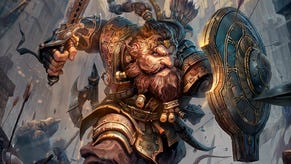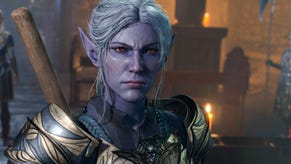D&D barbarian 5E guide: How to play a barbarian in Dungeons & Dragons
Rage against the Awakened Tree.
The barbarian class in Dungeons & Dragons 5E is known for running in weapon-first. Preceded by a signature battle cry of some sort, the classic D&D barbarian archetype is often some musclebound, axe-wielding warrior who prefers to swing first and ask questions later. Whether you’re looking to create a Conan the Barbarian-esque figure or something a little more unique, the 5E barbarian is ideal for players who want to control a ferocious, combat-focused character who thrives on taking damage.
Barbarians sit within a rough category of warrior archetypes within Dungeons & Dragons, joined by the fighter, the ranger and the paladin. Unlike the ranger and the paladin, the barbarian doesn’t really cast spells, and so is more like the fighter than any other class. Whereas the fighter class serves a more jack-of-all-trades combat role in the tabletop roleplaying game, the barbarian is specialised in close-ranged attacks.
Barbarian 5E guide
- Barbarian 5E starting proficiencies and equipment
- What is Rage and how do you use it?
- What is Reckless Attack and how do you use it?
- Which Primal Path should you choose?
- What’s the best race/species for Barbarian in D&D 5E?
If you’ve envisioned your character as an aggressive melee warrior who is able to harness any damage taken against their enemies, then barbarian is definitely the D&D class to choose.
In this barbarian guide, we’ll run you through the basics of the class, help you to create your character and answer some common questions about barbarians. Let’s get ready to create your character!
Barbarian starting proficiencies and equipment
Proficiencies are what your character is good at doing – whether that’s skills or equipment that they use. The barbarian class’ proficiencies understandably lean towards melee weaponry and survival. When it comes to saving throws - which is when players will need to roll a d20 in reaction to a threat aimed towards them - barbarians are particularly good at those that test their strength and constitution.
Barbarian 5E starting proficiencies
Barbarian players can choose to be proficient at two of the following skills:
- Animal handling
- Athletics
- Intimidation
- Nature
- Perception
- Survival
All of these skills reflect the barbarian’s natural affinity towards survival, intuition and physical presence. Which you choose will depend on what you prioritise and what kind of person your barbarian is. For example, selecting nature and survival would reflect a character who is familiar with the wilds, whilst intimidation and perception would better suit a character used to dealing with other sentient beings.

Firstly, a barbarian character may select from taking a great axe or any martial melee weapon, which can include weapons like swords and maces. Secondly, they can choose from between two handaxes, which can be thrown, and any simple weapon - which can include a ranged weapon. Lastly, they may choose from an explorer’s pack or four javelins.
When it comes to weapons, whichever you choose depends on what kind of damage you want your barbarian to deal out, with some weapons dealing slashing and others bludgeoning, for example. As for the explorer’s pack versus the javelins: it’s down to whether you’d like a wider variety of weaponry or some more utilitarian items at your disposal.
What is Rage and how do you use it?
Rage is easily the most recognisable ability in a barbarian’s toolset. In D&D 5E, the class has access to Rage straight from the get-go and many of the barbarian’s later abilities are intended to work with it. Rage is a state that barbarians can willingly enter in order to deal more damage, with the status lasting for a minute – which is a significant amount of combat rounds.
While in Rage mode, the player will gain advantage on strength checks and strength saving throws. Whenever a player performs a melee attack on an enemy, they’ll be able to add extra damage depending on what they roll on their Rage die – which will increase as they level up. On top of all that, while in Rage mode characters are resistant to bludgeoning, piercing and slashing damage – meaning that they take half the damage they would usually to those types of attacks.
Rage lasts for a minute but it can also be ended in a number of other ways, such as through a voluntary bonus action, if the character has not attacked a hostile creature or taken damage since the last turn, or if the character falls unconscious by running out of hit points.
Knowing the above rules is crucial to using Rage as a barbarian in 5E. Dealing and taking damage is what keeps a barbarian in the Rage state, with clever barbarian users being able to maintain their Rage state by carefully balancing the two. Targeting enemies you know you’re probably going to score a hit on is a good idea. If you’re not able to score an attack on an enemy this turn, then be sure that your character is able to take damage – but just the right amount of damage to prevent them from potentially falling unconscious. Giving out massive damage and taking a little is the ideal approach to playing a barbarian character in 5E, as it means that they’re able to stay in Rage mode for as long as possible.
What is Reckless Attack and how do you use it?
Barbarians gain Reckless Attack at second level, which grants the character the ability to “attack with fierce desperation”, according to the D&D 5E Player’s Handbook.
What this means in gameplay terms is that the feature allows you to make the first attack on your turn be a reckless one, meaning that it can be made with advantage – allowing you to roll two d20 and take the higher result – as long as it is a melee weapon attack and uses the strength ability score.
This will give your attacks a better chance of hitting or exceeding your target’s armour class number, which is what you need to in order to actually score an attack.
One really important detail to be aware of with Reckless Attack is that it also grants enemies advantage when attacking you. In typical barbarian fashion, the class’s abilities have a touch of danger to them. The key here is to be aware of potential threats that could use advantage against you to score a devasting blow – balancing risk-versus-reward is an essential part of playing the barbarian in 5E.

Which Primal Path should you choose?
At third level, 5E barbarians are able to choose from a selection of Primal Paths, which are subclasses that enable player characters to gain some additional abilities and feats on top of those they receive from the base barbarian line. Each Primal Path offers barbarians a unique approach to their class, allowing them to focus a bit more on what they enjoy about playing the class.
There are two different Primal Paths included in the Player’s Handbook, with many others available via other sourcebooks for D&D 5E and even homebrew options. Here we'll be covering the two Primal Paths found in the D&D 5E Player’s Handbook, but feel free to investigate outside of the core rulebook if you’re curious about options.
Path of the Berserker
If you’re looking to double down on the ferocious, killing energy of the barbarian, the Path of the Berserker is the Primal Path to go for. This subclass will power-up the barbarian’s existing arsenal, particularly Rage, to eventually turn them into a terrifying warrior who shakes off pain and deals out death.
Choosing this Primal Path will unlock Frenzy, an ability that enables the player to perform a melee weapon attack as a bonus action whenever they’re in Rage mode – allowing them to eventually be capable of performing a total of three attacks per turn.
The downside to this is that the character will suffer Exhaustion once their Rage ends. Exhaustion is a status that increases its effects as characters become more exhausted – starting with forcing players to roll disadvantage, by rolling two d20 and taking the lower result, when making ability checks. The full exhaustion table can be found in the D&D 5E Player’s Handbook.
Mindless Rage at sixth level will ensure the player character cannot be Charmed – which allows enemy forces to take control of your actions – or Frightened, which forces the character to do nothing but run away, while in Rage mode.
At 10th level, players gain Intimidating Presence, allowing them to force a creature to make a Wisdom saving throw against their DC + 8 + their Charisma modifier, with failure resulting in them being Frightened – with the option to extend this effect on future if they succeed. However, if a creature successfully defends against this, then the player cannot use this ability for another in-game day.
Finally, the last ability Path of the Berserker barbarians gain is Retaliation at 14th level. This ability allows a character to make a melee weapon attack against any creature that deals damage to them, as long as they are within five feet of them.
Path of the Totem Warrior
If you want to give your barbarian character some more utility, the Path of the Totem Warrior will be the better option. This Primal Path offers players the chance to connect with the animal kingdom without being a druid or a ranger, with many of its abilities revolving around beasts and creatures.
One important thing to note about this Primal Path is that its description in the D&D 5E Player’s Handbook includes liberal use of the term “spirit animal”, which we’re not going to use here in order to be sensitive towards the cultures of the Indigenous people the term originates from.

When players choose this subclass, their character will gain the ability to cast spells for the first time. Specifically, they can cast Beast Sense and Speak with Animals. While Beast Sense enables the character to experience what a creature that they can touch is experiencing, Speak with Animals grants players the ability to communicate with a beast for up to 10 minutes.
At 3rd level, barbarians following the Path of the Totem Warrior will acquire a totem spirit. This is a physical object, that barbarians can acquire or create themselves, which must contain something from one of three different animals: a bear, eagle or wolf.
Choosing the bear totem will enable your barbarian to become resistant to all forms of damage besides physical damage whenever they’re in Rage mode.
The eagle will force other creatures to have disadvantage on attacks of opportunity – which happen whenever a creature attempts to leave a combat encounter – against them whenever the attacker is in Rage mode, as well as allowing them to dash, move twice their movement speed, as a bonus action.
Finally, the wolf totem gives the barbarian’s allies advantage on melee attack rolls made against any enemies within five feet of them while they’re in Rage mode.
6th level unlocks Aspect of the Beast, an ability that will change depending on whichever animal type the player chooses - which can be different from their initial totem.
The bear totem allows the character’s carrying capacity to be doubled and gives them advantage on strength checks to push, pull, lift or break objects.
Meanwhile, the eagle totem allows the barbarian to see up to a mile away and to not roll at disadvantage on Wisdom checks if they’re in dim light.
The wolf totem grants the player character the ability to track other creatures whilst moving at a fast pace and enables them to move stealthily whilst traveling at a normal pace, both of which affect general journeying rules found in the Player’s Handbook.
At 10th level, a Path of the Totem Warrior barbarian will be able to cast Commune with Nature, a spell that allows players to ask questions regarding the surrounding environment, such as about various plants and creatures in the area.
Finally, 14th level unlocks the Totemic Attunement feature – gifting the character a different ability based on whichever animal they choose from.
Picking the bear will force enemies within five feet to you to roll with disadvantage when making attacks against anyone besides you if you’re Raging.
The eagle will give the player flying speed equal to their walking speed when they are Raging, literally allowing them to fly.

Choosing the wolf will give the player a bonus action to knock a Large or smaller creature prone whenever they hit it with a melee weapon attack when they’re Raging. This means that creatures sized Large or smaller can be knocked down by your character, with the player being free to ask the DM a creature’s size.
What’s the best race/species for Barbarian in D&D 5E?
Though technically any playable race/species found in Dungeons & Dragons 5E can be paired with the barbarian class, there are some that are better suited to it than others. Obviously, the idea of a gnome yelling and swinging around a battleaxe is funny, but it won’t necessarily mean that you’re taking full advantage of the barbarian class’ abilities.
There are plenty of playable species to choose from in D&D 5E, including several options found in other sourcebooks and adventures – as well as homebrew content. Here we’re going to cover some options included in the Player’s Handbook.
The most straightforward choice for a barbarian character is the half-orc, purely due to the fact that characters of this species get a two-point increase to their Strength and one point to their Constitution score – the two ability scores that barbarians use the most.
On top of that, half-orcs have proficiency in the Intimidation skill from the get-go, have the Relentless Endurance ability – which allows the character to drop to one hit point when they would otherwise end on zero – and the Savage Attacks ability, which enables them to roll an additional die when dealing damage with a melee weapon attack. All of these extra benefits work extremely well with a barbarian build.
Alternatively, players could pick a dragonborn character. Choosing a dragonborn will get players a two-point increase to their Strength score and a one-point increase to their Charisma, which can be useful when using Intimidating Presence.
Additionally, players can choose what kind of dragonborn their character is in order to acquire an extra benefit in a certain breath attack and resistance to a particular type of damage, with your choice possibly being affected by the environment you’re playing in, such as a snowy or fiery one.
Selecting a mountain dwarf could also be a good option for a barbarian character, thanks to the fact that they get a two-point increase to their Strength score on top of the two-point increase to Constitution that all dwarves receive. Furthermore, dwarves have automatic proficiency in using battleaxes, handaxes, light hammers and warhammers – giving your barbarian more options for what weapons they can use in battle.













